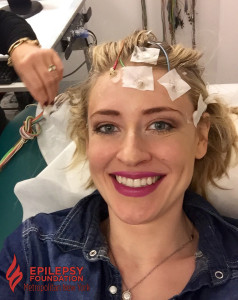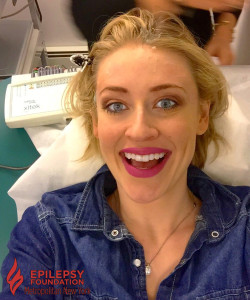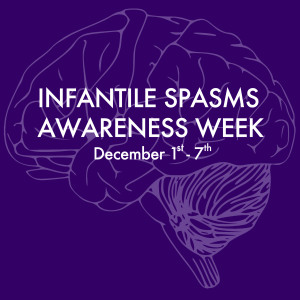I Can Spell Electroencephalogram (EEG)
Recently, my neurologist ordered an EEG test for my epilepsy. EEG stands for electroencephalogram. An EEG records the electrical activity in your brain and it helps doctors detect abnormal electrical activity of the brain. Most types of EEG tests are considered relatively painless. However, like any medical test, from scheduling to prepping for the test, an EEG can always include some inconveniences and annoyances. Anyone who has ever had to remove EEG glue from their hair, understands why I call an EEG “relatively” painless.

I had my first EEG test shortly after I was originally diagnosed with epilepsy when I was six years old. When my parents told me I had to undergo a new test related to my epilepsy, my first question was: “Are there any needles involved?” Luckily, my parents reassured me I would not be receiving a shot, getting an I.V. drip, or giving any blood. Plus, since my doctor prescribed me a sleep deprived EEG, the test prep required me to stay up late, preferably all night. Also, I got to miss a day of school, which was pretty cool! The next morning, my mother took me to my neurologist’s EEG lab. I was placed on a hospital bed and the technician glued electrodes to my head. After an hour of the technician asking me to breathe deeply and blink my eyes, they let me fall asleep. After I woke up, my electrodes were being removed from my head, and I returned home to go to bed. After several sleep deprived EEGs, I realized my mom also had to stay awake all night with me and miss work the next day. While I got to fall asleep for four hours during my EEG, my mom remained awake speaking with the technician or doctor. Now, as an adult, I understand how much an epilepsy diagnosis affects the entire family, from diagnosis to treatment.
In my twenties, I underwent a medication change because I began having a lot of seizures, again. My neurologist prescribed me several 72 hour ambulatory EEGs. For three days, I had a head full of glued-on electrodes. The electrodes were connected to wires, and the wires were connected to a small box recording the results. I could go anywhere, as long as I was still connected to my EEG box and electrodes. At work, I hid my electrode-covered head with a stylish beanie or scarf, allowing me to feel “normal.” Unfortunately, by the end of the first 48 hours, my head was itching like crazy. There was no beanie or scarf to alleviate my itchy head without removing the electrodes; but if these were to fall off, the EEG may have to be repeated! Finally, after the 72 hours, I would return to my neurologist’s office to have the electrodes removed.
After any EEG, the inevitable issue of how to remove EEG glue arises. During this period of my life, I was not connected with the Epilepsy Foundation of Metropolitan New York, so I did not know the Epilepsy Foundation’s magic trick for removing EEG glue:
· Add 5 to 7 crushed aspirin to half a cup of hot water to dissolve. Then, add 2 good size squirts of shampoo, 4 tablespoons witch hazel or seabreeze, and mix well together. Massage the mixture through wet hair and let it sit for about 15 to 20 minutes. Finally, begin to comb through your hair after an allotted time has passed. Rinse and use shampoo and conditioner as usual.
I have never had to undergo a video-telemetry EEG test, which requires a patient to spend days in a hospital wearing an ambulatory EEG box, while being recorded by a video camera. Additionally, during a video-telemetry EEG test, epilepsy medications may be reduced or withdrawn, to increase the chances that you will have a seizure that can be recorded. So, while there are rarely needles involved, I would not dare to categorize all EEGs as “painless.”
 My recent standard EEG lasted for one hour and took place at my doctor’s office. It was the easiest EEG I had ever experienced. But, like epilepsy, even the types of EEG tests can vary. Like any medical procedure, it is important to stay informed and well prepared for an EEG test. The information an EEG test provides is essential for doctors treating epilepsy. Thankfully, this past EEG was totally painless because I finally knew how to remove EEG glue from my hair!
My recent standard EEG lasted for one hour and took place at my doctor’s office. It was the easiest EEG I had ever experienced. But, like epilepsy, even the types of EEG tests can vary. Like any medical procedure, it is important to stay informed and well prepared for an EEG test. The information an EEG test provides is essential for doctors treating epilepsy. Thankfully, this past EEG was totally painless because I finally knew how to remove EEG glue from my hair!
Prognosis in Infantile Spasms – #EpilepsyNYC Infantile Spasms Awareness Week
Summary:
– The overall intellectual and neurodevelopmental outcome in children with infantile spasms is generally poor
– The long-term prognosis is directly related to the underlying cause of the seizures
– Better developmental outcomes are noted in patients without an identified cause (cryptogenic/idiopathic)
– Although the spasms tend to resolve by early to mid childhood, a majority of the children develop other types of seizures and epilepsies.
– There is a better outcome noted in those patients treated earlier in the course of their seizures, and in those that have an early and sustained response to treatment.

Infantile Spasms
The long-term prognosis of patients with infantile spasms has been studied extensively over the years. Many studies have examined the outcome of infantile spasms including neurodevelopmental and intellectual disabilities, prognostic significance of the EEG, and the development of chronic epilepsy.
The consensus of all of these studies is that the overall outcome, with regards to chronic epilepsy and neurodevelopmental disability is generally poor in patients with infantile spasms.
Chronic Epilepsy
Epileptic spasms usually resolve, latest by mid-childhood, in the majority of patients. Infrequently, spasms may persist in adulthood. Even if the spasms resolve, it has been found that 50-70% of the patients will develop other seizure types. Approximately 50% of the patients with a history of infantile spasms go on to develop chronic intractable epilepsy. There is a strong relationship seen between a history of infantile spasms (IS) and development of Lennox- Gastaut syndrome, with 18-50% of IS patients developing Lennox-Gastaut syndrome.
EEG
While features of hypsarrhythmia define the EEG of patients with infantile spasms, evidence of this abnormality on the first EEG was seen not to influence the response to treatment. However, if the hypsarrhythmia persisted despite treatment, or was atypical and/or asymmetrical, this was seen to adversely influence the long-term outcome.
Neurodevelopmental disability
The most important factor in predicting the cognitive and developmental outcome of patients is etiology.
Mental retardation occurs in about 70 % of patients with infantile spasms, usually involving severe to profound retardation and often associated with other psychiatric problems. Other neurological deficits, such as cerebral palsy, may be seen in about 30-50% of patients.
Most children with infantile spasms experience slowing, plateauing, or regression of their developmental progress.
Studies have consistently shown that infants with symptomatic infantile spasms are at much higher risk (86-90%) of developing mental retardation, autism and other behavioral and cognitive disabilities, compared to infants with idiopathic infantile spasms. Symptomatic infantile spasms, in particular, are associated with autism spectrum disorders (ASD) in up to 35% of cases.
10-20% of patients with normal development prior to the start of their spasms will have normal mental function or only be mildly impaired long-term. 28-50% of patients with idiopathic infantile spasms will go on to have normal or borderline cognitive development.
Mortality
The premature death rate for infantile spasm ranges from 5-31%. Most of the deaths (61%) occurred at or before age 3 years, while only 10% occurred after age 20 years.
In most cases, the mortality is seen to be a result of the underlying neurological cause of the infantile spasms.
Factors for a favorable outcome in Infantile Spasms
• Cryptogenic or idiopathic cause
• Age of onset of spasms > 4 months
• No atypical or partial seizures
• Typical EEG abnormalities – hypsarrhythmia
• Early onset of treatment
• Early and good response to treatment
Treating Infantile Spasms – #EpilepsyNYC Infantile Spasms Awareness Week
Infantile spasms is a potentially devastating early-onset epilepsy that affects infants, typically between three and nine months of age. Many cases of infantile spasms occur in children who are already have brain abnormalities, such as children with tuberous sclerosis, down syndrome, or brain injuries sustained as newborns. However, in about one third of affected infants, infantile spasms occur for no known reason.
There are three first-line treatments used for infantile spasms. Most pediatric neurologists select one of these three as the initial treatment.

First, adrenocorticotropic hormone (ACTH) is a naturally occurring hormone that is made by the pituitary gland. It stimulates the body to produce steroids. There are several versions of ACTH available throughout the world — in the US, physicians can prescribe a pharmaceutical grade purified ACTH for infantile spasms. ACTH must be given by injection into the infant’s thigh twice a day for two weeks, and then gradually tapered over the next several weeks. There are significant side effects. Many babies become very irritable when taking this medication. It increases their appetite, and some gain weight during treatment. ACTH can also increase blood pressure and, on occasion, lead to an increase in the size of the heart. These side effects fade after the medication is stopped.
Second, oral prednisolone is a corticosteroid, which comes as a liquid. This is the same medicine given for children with asthma attacks; although, for infantile spasms we use a higher dose for a longer period of time (usually several weeks). It can have the same side effects as ACTH, but these are usually less severe.
Third, vigabatrin is a medication that comes as a packet of powder, which can be disolved in water. The major worrisome side effect of vigabatrin is loss of peripheral vision. This is uncommon. Usually when vigabatrin is prescribed, the infant will also need to see an ophthalmologist to monitor for this potential side effect.
Current evidence suggests that ACTH has the best overall response rate. The one exception is that for children who have infantile spasms due to tuberous sclerosis, vigabatrin seems to work better.
First-line therapy works between half and three quarters of the time. If it fails, there is not good evidence to guide us on what to try next. Many physicians will switch to a different first-line agent. For example, if a child continues to have seizures after ACTH, the physician may try vigabatrin next. Rarely, a deficiency of vitamin B6 can cause infantile spasms, and many physicians will give infants this vitamin. Other physicians may try dietary therapy. For example, there is a diet called “the ketogenic diet” that avoids carbohydrates and sugars. This diet can lead to changes in how the brain makes fuel for itself, which can, in turn, reduce seizures.
In some cases, children with infantile spasms may have a subtle area of the brain which is abnormal, which is difficult to see on MRI scans. Some physicians will order other kinds of brain scans, such as a PET scan (positron emision tomography), in order to look for these kinds of abnormalities. This is important, because some infants benefit from epilepsy surgery to remove the abnormal area of brain.
Dr. Zachary Grinspan, MD
Weill Cornell
Me and My Epilepsy – Mrs. Gotham City
My name is Alexandra DeBourcy and my epilepsy is a part of my life, my history and my future.
I was diagnosed with epilepsy at the age of five, when my parents noticed I was having “head tics.” Shortly after starting my epilepsy medication, I stopped experiencing myoclonic tics. As a 5 year-old, I did not understand the full extent of my diagnosis, but I recognized a change in my lifestyle. At that very young age, I had to swallow non-chewable prescription medication, undergo many boring diagnostic tests and take monthly blood tests. The blood tests were the worst. Even at five, I knew my epilepsy diagnosis was changing my life.
Despite years of living seizure-free, one day during class when I was in the 7th grade, I had my first ever grand-mal seizure. When I awoke, I was still in school, surrounded by working paramedics, as well as teachers and school administrators whose faces were filled with panic and fear. It took me a while to understand I had just had a seizure. At the time, I could only think about how my peers, who also witnessed my seizure, would judge me. Prior to returning to school, I called some of the students in class. It was easier to explain my epilepsy on a one-on-one basis. It helped. I don’t know if my phone calls helped any of my classmates, but it I do know it helped me. It gave me strength to face my schoolmates. I had more grand mal seizures in school during my adolescence, but I continued to open up and discuss my epilepsy with classmates and adults.
Luckily, I remained seizure free during high school and most of college, but my epilepsy was still a part of me. My parents and doctors reinforced the need for me to communicate my disorder to my friends, teachers and professors. No matter how long I went without a seizure, I had a different lifestyle than my peers. I was approaching the age where my actions, especially as a driver, had a greater effect on the lives of others. So, I continued to use communication, and levity, to introduce my epilepsy to other people.
After graduating from Syracuse University, I started having grand-mal seizures, again. This added additional considerations, as I was about to begin my career search. My epilepsy stabilized, and I moved to New York City. I loved New York City, and it had a public transportation system I could depend on. I was able to find work at an ad agency with an insurance plan. Since I had been denied a private insurance due to my pre-existing condition.
Unfortunately, I continued to experience seizures through out my twenties. I also experienced the Great Recession, the election of our first Black President, and falling in love with my husband. Eventually, my doctors and I decided to change medications. I had seizures at work. Some of my colleagues were empathetic; others were not. I sometimes felt stigmatized in my work environment. Due to privacy laws, it was hard for employers and colleagues to talk openly with me about my epilepsy.
Eventually, I left advertising. It was not the best career environment for my epilepsy. I decided to change careers and become a gemologist. My change in careers has allowed me to work in an environment more suitable for my epilepsy. I also work very happily with diamonds, gems and beautiful jewelry. It also has provided me with more time to devote to helping others with epilepsy. I now have the chance to represent the Epilepsy Foundation of Metropolitan New York as Mrs. Gotham City in the upcoming Mrs. New York America pageant.
I have had to accommodate my epilepsy throughout my entire life and, many times, I have resented my epilepsy. However, the happiest times in my life occurred when I worked with my epilepsy without shame. It is embarrassing to have a seizure in school or at work. It is awkward to tell peers about a personal neurological disorder. Furthermore, it is difficult to disguise EEG electrodes for three days straight. So, as an epileptic, I know I can empower myself by starting the conversation on my epilepsy. I want to continue and expand the conversation with others living and affected by epilepsy. It is the best way I know to keep myself safe and happy. We need to discuss new treatments, gather community support and take the stigma away from epilepsy.
